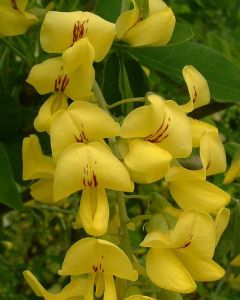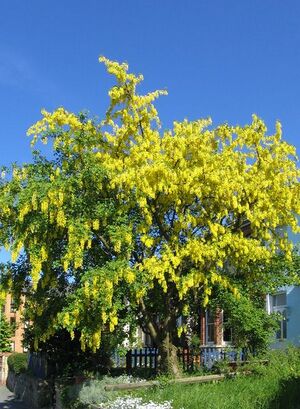Laburnum
| Laburnum {{{status}}} Fossil range: {{{fossil_range}}}
| ||||||||||||||||||||||||||||||||||||||||||||||||||||||||||||||||||
|---|---|---|---|---|---|---|---|---|---|---|---|---|---|---|---|---|---|---|---|---|---|---|---|---|---|---|---|---|---|---|---|---|---|---|---|---|---|---|---|---|---|---|---|---|---|---|---|---|---|---|---|---|---|---|---|---|---|---|---|---|---|---|---|---|---|---|
 Common Laburnum - flowers | ||||||||||||||||||||||||||||||||||||||||||||||||||||||||||||||||||
| Plant Info | ||||||||||||||||||||||||||||||||||||||||||||||||||||||||||||||||||
| ||||||||||||||||||||||||||||||||||||||||||||||||||||||||||||||||||
| Scientific classification | ||||||||||||||||||||||||||||||||||||||||||||||||||||||||||||||||||
| ||||||||||||||||||||||||||||||||||||||||||||||||||||||||||||||||||
| [[{{{diversity_link}}}|Diversity]] | ||||||||||||||||||||||||||||||||||||||||||||||||||||||||||||||||||
| {{{diversity}}} | ||||||||||||||||||||||||||||||||||||||||||||||||||||||||||||||||||
| Binomial name | ||||||||||||||||||||||||||||||||||||||||||||||||||||||||||||||||||
| {{{binomial}}} | ||||||||||||||||||||||||||||||||||||||||||||||||||||||||||||||||||
| Trinomial name | ||||||||||||||||||||||||||||||||||||||||||||||||||||||||||||||||||
| {{{trinomial}}} | ||||||||||||||||||||||||||||||||||||||||||||||||||||||||||||||||||
| Type Species | ||||||||||||||||||||||||||||||||||||||||||||||||||||||||||||||||||
| {{{type_species}}} | ||||||||||||||||||||||||||||||||||||||||||||||||||||||||||||||||||
| Species | ||||||||||||||||||||||||||||||||||||||||||||||||||||||||||||||||||
| Laburnum anagyroides Laburnum alpinum | ||||||||||||||||||||||||||||||||||||||||||||||||||||||||||||||||||
| [[Image:{{{range_map}}}|{{{range_map_width}}}|]] | ||||||||||||||||||||||||||||||||||||||||||||||||||||||||||||||||||
| Synonyms | ||||||||||||||||||||||||||||||||||||||||||||||||||||||||||||||||||
| {{{synonyms}}} |
Laburnum is a genus of two species of small trees in the subfamily Faboideae of the pea family Fabaceae, Laburnum anagyroides (Common Laburnum) and L. alpinum (Alpine Laburnum). They are native to the mountains of southern Europe from France to the Balkan Peninsula. Some botanists include a third species, Laburnum caramanicum, but this native of southeast Europe and Asia Minor is usually treated in a distinct genus Podocytisus, more closely allied to the brooms.

They have yellow pea-flowers in pendulous racemes 10-30 cm (4-12 in) long in spring, which makes them very popular garden trees. In L. anagyroides the racemes are 10-20 cm (4-8 in) long, with densely packed flowers; in L. alpinum the racemes are 20-30 cm (8-12 in) long, but with the flowers sparsely along the raceme.
The leaves are trifoliate, somewhat like a clover, the leaflets typically 2-3 cm (¾-1¼ in) long in L. anagyroides and 4-5 cm (1½-2 in) long in L. alpinum.
Most garden specimens are of the hybrid between the two species, Laburnum x watereri (Voss's Laburnum), which combines the longer racemes of L. alpinum with the denser flowers of L. anagyroides; it also has the benefit of low seed production (Laburnum seed toxicity is a common cause of poisoning in young children, who mistake the seeds for peas).
The yellow flowers are responsible for the old poetic name 'golden chain tree' (also spelled golden chaintree or goldenchain tree).
All parts of the plant are poisonous and can be lethal if consumed in excess. Symptoms of Laburnum poisoning may include intense sleepiness, vomiting, convulsive movements, coma, slight frothing at the mouth and unequally dilated pupils. In some cases, diarrhea is very severe and at times the convulsions are markedly tetanic.
Despite the plant's toxicity, it is used as a food plant by the larvae of some Lepidoptera species including Buff-tip.
References and external links
- Flora Europaea: Laburnum
- ILDIS Legume Database
- time lapse video of a year in the life of a laburnum tree.
- Grieve, 'A Modern Herbal' (1931)